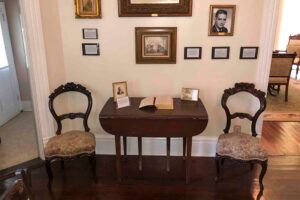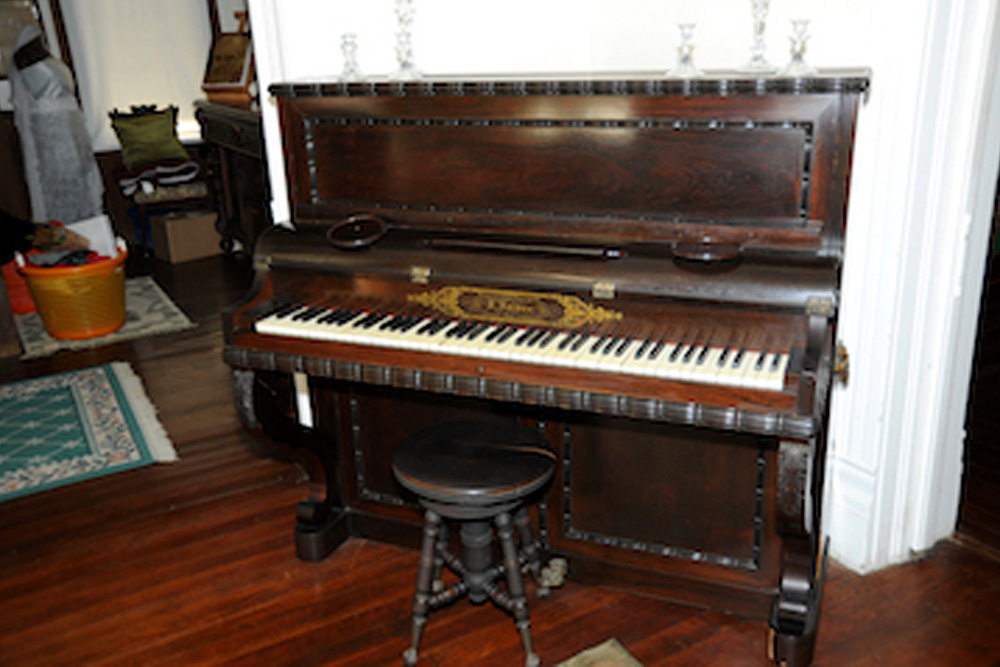The house piano was built by Jules Faivre.
Faivre was apparently a Paris piano maker, who advertised his ‘patented wrought iron system’, which was on display for sale at his warerooms at 156 Royal Street, New Orleans, LA. Here a ‘large assortment of Parisian pianos’ might also be inspected by the clients.
— From “Makers of the piano Vol. 2: 1820–1860”, by Martha Novk Clinkscale, Copyright © 1999 Oxford: Clarendon Press. Reproduced with permission of the Licensor through PLSclear.
He invented the iron frame piano and the wrought iron system which can be heard being used in wild western movies and shows today.
He produced pianos from roughly the 1840s to 1861. He sold his pianos on 156 Royal Street in New Orleans out of his warehouse.
Around the time of the civil war pianos were so popular that they were sold for roughly $230. At one point he along with others were “giving” pianos away as a gimmick as advertised in the 1861 New Orleans Picayune.

Prize at the universal exposition 1855 (similar to a world fair)
This particular piano was from the Exposition Universelle des produits de l’Agriculture, de l’Industrie et des Beaux-Arts de Paris 1855. This was the equivalent to the world’s fair today. The Exposition Universelle of 1855 was held on the Champs- Élysées in Paris from 15 May to 15 November. This exposition was designed and celebrated during the reign of Emperor Napoleon III. It was the counterpart to the London’s Great Exhibition of 1851, the first of its kind, and the monumental Palais de l’Industrie was constructed in emulation of London’s Crystal Palace.
China cabinet
This china was purchased in the early 1800s for Volumnia W. Hunley Barrow. During the Civil War when the Union soldiers were getting closer these pieces were buried so that they were not destroy by the pillaging of the troops. In later years they came under possession of a family friend. The friend gave the china back to the family through Mary Buck Gaidry. Mary left it in her will to return it to Residence Plantation. Mary also gave her china and china cabinet to Residence. The buffet at the end of the stairs was also hers.
— Information from Mary B. Gaidry
Two Antique Chairs

Roberta G. Peil had these two chairs in her possession. They belonged to her Great Grandmother. Her Grandmother gave them to a servant in the 1800s. One day a lady from Labadieville called her and said these chairs were given to her grandmother and she was going to throw them away. Roberta got the chairs back and had them refinished and recovered. They are back now back where they originally came from.
— Information form Roberta Gaidry Peil
1908 Style VV-XVI Victrola aka “Victrola the 16th”
- Model number 45311 D
- Made of Mahogany
Victor Talking Machine Company was founded by Eldridge Johnson in 1901. He improved the phonograph by getting rid of the large horn on the top, improved the sound box by having it act as the horn. He also improved the arm, and made a quieter spring motor.
Family portraits
Born in 1802 in Halifax County, North Carolina.
He was the second son and third oldest child out of four of Bartholomew and Ascension Slatter.
He worked with his brother, R.R. Barrow in purchasing land around Houma. He died on 1842.
Wilson Joseph Gaidry Sr. was born on September 4, 1866 and was the oldest of nine children of Adolph A. Gaidry and Aglae Cadiere from Thibodaux. He received a degree from a business school in Tennessee.
Wilson Gaidry I married Clara Slatter and helped her mother Volumnia (Roberta) Barrow Slatter run the farm. They had three children: Harold Langdon Gaidry (1898 – 1952), Wilson Joseph Gaidry II (1901 – 1973) and Roberta L Gaidry (1913 – 2000).
W.J. Sr. oversaw work in the cane fields which was Roberta’s main form of income. However she also had pigs, chickens and cows. Wilson bought a dozen cows and Clara bought 200 chickens. He sold milk and eggs to the citizens of Houma out of his milk wagon. He got the milk money and she got the egg money and that’s how Residence Dairy got started.
W.J. Sr. died from injuries in a Model T Ford accident on River Road on January 16, 1925 at the age of 56. He was buried in Magnolia Cemetery in Houma.
Wilson Joseph Gaidry Jr. was born on September 9, 1901 in Houma Louisiana to W.J. Gaidry Sr. and Clara Katherine Slatter. Wilson Jr. flipped a coin with brother Harold Langdon Gaidry to see who would go to college and who would take care of the farm. Wilson would run the farm. He would marry Lillie Lea McKnight and produced only one child Wilson Gaidry III.
In the 1940s his dairy business was flourishing. They owned 60 milking cows and bought milk from other farms to meet demand. During WWII, Civil defense groups were organized in case of attack. Wilson Jr. was head of one group and wore a helmet with CD in a triangle. One night an oil tanker was torpedoed in the Gulf south of Cocodrie so close to the shore that people could see the ship burning from the shore. The Nazis were preparing to invade Terrebonne Parish near Cocodrie. The Civil Defense Force began assembling in the front yard around Wilson Jr’s old red Ford model B pickup truck with their old hammer 12 gauge shotguns to prepare to repel the Nazi invasion. The next day the Nazis got wind of what awaited them and canceled the invasion. After the war in the 1950s big out of state milk companies began to sell milk in Terrebonne Parish and a price war ensued. In 1954 after the death of his mother Clara he inherited the property. In 1966 he was forced to convert his dairy farm into a beef farm which is still in production today.
Wilson Gaidry Jr. died of a heart attack on September 21, 1973 at the age of 72. He was buried at Magnolia Cemetery.
Wilson Gaidry III was born on March 30, 1939 to Wilson Gaidry Jr. and Lillie Lea McKnight.
In 1961 Mr. Gaidry earned a Bachelors Degree in biology at the University of Southwestern Louisiana now known as LSU Lafayette and during his career he worked to help prevent coastal erosion. He was a Marine Biologist and Area Study Leader for the Louisiana Wild Life and Fisheries from 1963-1973 during which he authored and Co-authored numerous publications on Louisiana Estuarine Ecology and Louisiana Shrimp Population Dynamics. He also Served on Governor Blanco’s Transition Team and served as a Commissioner for Louisiana on the Gulf State Marine Fisheries Commission; Councilman for Governor Edwards on the Louisiana Fur and Advisory Council. He built, designed owned and operated Gulf Shrimp Fishery Vessels and fishing gear.
Today he runs day to day operations for his cattle business and antique restoration projects for the farm. His wife, Wanda, runs his real estate business and oversees the curating of the main house . His first marriage was to Barbara Beard and they had four children: Natalie Gaidry DeAngelis, Roberta Gaidry, Laura Bell Mary Gaidry and Rebecca Lynn Gaidry Ritchey. Today he is married to Wanda Ledet Gaidry and they work on preserving their family history for the community and their family. They have several grandchildren including Douglas, Miranda and Ruth Ann Pecot, Trevor Billings, Brooke Sanford and CJ Ritchey. His Son-in-laws Cody Ritchey help run day to day operations and Valerio DeAngelis helps with research along with running the website.
Houma Grey Baseball Team
From roughly 1925 to 1931 Wilson “Piggy” Gaidry Jr. played on the local team the Houma Greys.
Alexander John Drysdale (1870-1934) was an early 20th century artist who painted Louisiana landscapes using oil wash which gave his paintings a hazy look. He did this by mixing kerosene and using cotton balls. He has roughly 10,000 works. His art today can having a starting value of $230 for small painting and around $300,000 for his larger works.
He was involved with the Artists Association of New Orleans and his studio was at 320 Exchange Place in the French Quarter.
George Dixon, captain of the Hunley submarine, was given a $20 gold coin by his sweetheart when he left for war. During the Battle of Shiloh he was shot but hit the coin in his trouser pocket, thus saving his life. When they raised the Hunley on October 2001 they found the coin on his hip bone that was warped from a bullet with traces of lead.
On one side was Lady Liberty. On the other side it was sanded and inscribed:
Shiloh
April 6th 1862
My Life Preserver
G.E.D.
- Made by the Ansonia Clock Company between 1880s to 1910s.
- The company was founded in 1851 by Anson Greene Phelps in Ansonia, Connecticut.
- If the clock is marked Connecticut it was produced before 1879. If marked New York it was produced after their expansion in 1880.
- The rights of the company were sold in 1969.
















































